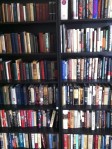 Back when I was still a wee sprite struggling through the vagaries of junior high school, there was an organization called Reading is Fundamental, aka, RIF (not to be confused with Reduction in Force, another RIF program in which the government shed it “excess” workers). The continuing purpose of Reading is Fundamental is to improve literacy through education and, get this, give free books to kids in need. I likely got a few myself.
Back when I was still a wee sprite struggling through the vagaries of junior high school, there was an organization called Reading is Fundamental, aka, RIF (not to be confused with Reduction in Force, another RIF program in which the government shed it “excess” workers). The continuing purpose of Reading is Fundamental is to improve literacy through education and, get this, give free books to kids in need. I likely got a few myself.
Now I’m a huge reader tallying at least 50 books a year; in 2014 I read 84 books. My tendency over the past decade was to read almost exclusively non-fiction, but a couple of years ago I read one novel. Last year it was around a half dozen, and this year I read 16 fiction books, almost a fifth of my total.
Some of this fiction was trying to catch up on “classics,” books that are routinely on “must read before you die” lists, and books that I’ve always wanted to read but somehow never did. Some of these were great (Fahrenheit 451, Lolita, The Alchemist) while others begged the question as to how they could possibly have become cult classics (Tropic of Cancer, Confederacy of Dunces, The Hitchhikers Guide to the Galaxy).
Non-fiction books remained the focus of my reading, not the least of which was because of my continuing fascination with Abraham Lincoln. I finished 23 books about Lincoln, about 27% of my reading this year. To be honest, that’s even more impressive than it sounds because I took notes on every one of those 23 books as I continue researching my own forthcoming Lincoln book.
Non-Lincoln non-fiction books included more than a few deep, long, and psychologically grueling tomes. Wild Swans by Jung Chang and The Rape of Nanking by Iris Chang (no relation) offered incredible insights into China leading up to World War II and then into the cultural revolution. These books were beautifully written and engaging, though their topics brought great sadness along with their powerful insight. Donna Tartt’s The Goldfinch also was a mighty tome filled with angst and insight. All were well worth the lengthy reads.
I also read two fascinating books on art. Ross King’s Leonardo and the Last Supper and Jonathan Harr’s The Lost Painting (about a long-missing Caravaggio) fed my ever-growing appreciation of the art world. I’ve been lucky enough to see many of the most famous artwork in their home settings.
And then there is the writing. While I had written many scientific articles, reports, and analyses over my long scientific career, and while my non-technical writing also is generally well-received, I’m always looking to improve my creative skills. Fifteen of the 84 books (18%) were in one way or another related to the craft and business of writing.
So what about 2015? I’ll continue to read, of course, but my plan is to reduce my reading goal. In 2014 it was 75, which I surpassed, but in 2015 I’m setting my goal at 50 books. The downsizing is to allow me to focus on writing, in particular, my own book on Lincoln’s “science” interests. I’ll also finish writing a separate e-book linking my other favorite historical figure – Nikola Tesla – with Abraham Lincoln, but the Lincoln book gets precedence.
And yes, I expect to still read more than the 50 books.
Check out my author page on Goodreads for more on my reading challenge, and happy reading!
© David J. Kent 2014
David J. Kent is the author of Tesla: The Wizard of Electricity and Nikola Tesla: Renewable Energy Ahead of Its Time.


明けましたおめでとうございます!(Happy New Year!)
I’m impressed…84 books! Sadly, I also think of Iris Chang in that regard. The compulsion to communicate one’s passions can be a blessing or a curse — though the Scott Adams on your list suggests a somewhat lighter perspective.
LikeLiked by 1 person
I read so much about Lincoln and other “heady” non-fiction books that I force myself to occasionally fit in something to lighten the load on my brain cells (hence the Dilbert). The Chinese history books are background for a collaborative project (plus my general interest).
This year – less reading, more writing. It’s going to be a big year.
LikeLiked by 1 person
My field of work left me primarily committed to technical reading due to a constant need to stay up-to-date. I have a wall’s worth of technical and reference texts, presently committed to several boxes. This is a serious “downsizing” year for me, so about a third of my library was also sent away. If I feel industrious, I may try to improve my Japanese reading skills this year (presently painfully slow).
LikeLike
I can relate to that. I went many years reading nothing but “work” and “school” related peer-reviewed papers and reports. Then a few years ago a friend got me started on a “read 50 books a year” kick. I’ve surpassed it every year since (and she has never quite reached 50).
I’m also trying to downsize. I need to get rid of non-Lincoln books to make more room for Lincoln books. 🙂
LikeLike
Pingback: Reading List Halfway Point | Hot White Snow
Pingback: Reading List Halfway Point (from Hot White Snow) | Science Traveler
Pingback: Reading Time – 2015 | Hot White Snow
Pingback: Reading List Halfway Point – 2015 | Hot White Snow